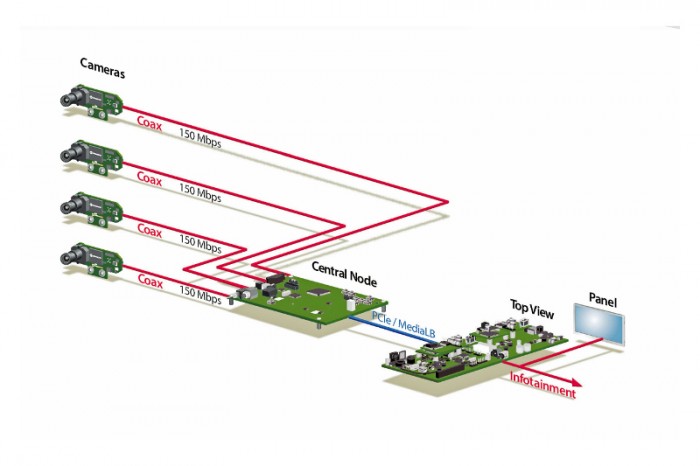The latest MOST150 architecture increases streaming bandwidth and efficiency

MOST150 design enables streaming bandwidth increase
Photo by MOST Cooperation
The MOST Cooperation (MOSTCO) – the standardization organization for the leading automotive multimedia network Media Oriented Systems Transport (MOST) – presents the latest MOST150 architecture, enabling a streaming bandwidth of up to 1.2 Gbit/s. A multiport network interface controller allocates the true, full bandwidth of up to 150 Mbit/s in up to 8 branches. The different branches can be built with any topology, including star, ring, tree or daisy-chain. They can be hot-plugged or disconnected without influencing the flow of streaming data in the rest of the system. This flexibility can be used for applications such as a surround view camera system of up to eight cameras in a driver assist system (ADAS) network.
Video Streaming with Low Latency and Determinism
“Sending a video stream from the camera to the renderer means that a significant amount of video data is streamed for a prolonged period of time,” explained Dr. Wolfgang Bott, Technical Coordinator of the MOST Cooperation. “The continuously flowing streams of data are not interrupted or delayed. The MOST Technology provides the transport of data streams with guaranteed bandwidth and ultra-low latency.” It requires neither additional communication processors, nor addressing overhead, nor the bandwidth-wasting process of breaking up the data into packets that then need to be examined every time they go through a device along the route. Complying with safety protocols, MOST delivers video streams with low latency and determinism throughout the system.
The MOST multi-channel network approach with its inherent synchronicity due to the TDMA (Time Division Multiple Access) mechanism is perfectly adapted for ADAS, since it assures real-time determinism and ultra-low video latency at less than ten milliseconds.
For more information, please visit http://www.mostcooperation.com.
News Categories
- » NEWS HOME
- » Automation & Robotics
- » Industry 4.0
- » Material Handling
- » Sensors
- » Quality & Testing
- » Machine Vision
- » Laser & Optics
- » Metalworking
- » Motion Control & Drives
- » Hydraulics & Pneumatics
- » Process Industry
- » Renewable Energy
- » Agriculture
- » Home & Office Furniture
- » Environmental Tech




